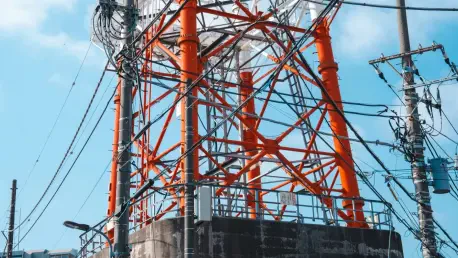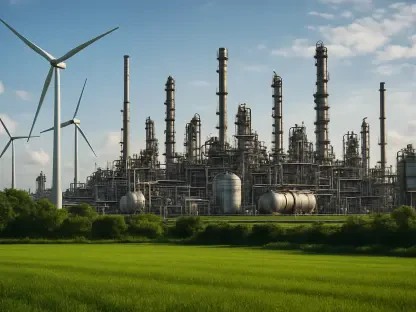In an era marked by surging global energy consumption and an accelerating shift toward renewable resources, power transmission systems have faced considerable obstacles. Traditional alternating current (AC) systems, long the backbone of electricity distribution, are increasingly strained by the advent of renewable energy sources with their inherent variability and distributed nature. High Voltage Direct Current (HVDC) and Flexible AC Transmission Systems (FACTS) have emerged as revolutionary solutions to these challenges, playing essential roles in modernizing infrastructure and ensuring the efficient, reliable transfer of energy across vast distances.
The Transformative Power of HVDC
Efficiency in Energy Transfer
High Voltage Direct Current (HVDC) technology stands as a cornerstone in the quest to optimize energy transmission, offering unmatched efficiency pertinent to transporting electricity over extensive distances with negligible energy dissipation. This capability is pivotal in the seamless integration of renewable energy sources, particularly from remote locations like offshore wind farms to urban onshore power grids. HVDC’s unique design allows for the efficient movement of electricity with lower transmission losses than traditional AC systems, making it a crucial technology as energy demands grow and sustainability becomes a priority. Moreover, HVDC systems can stabilize grid operations, especially in areas where renewable energy inputs are increasing, by providing steadfast power transfer even across asynchronous grids. The scalability and adaptability of HVDC technology make it indispensable for integrating disparate regional power networks, thereby fostering a more cohesive global energy market.
Infrastructure and Cost Benefits
By utilizing only two conductors, instead of the three required for AC systems, HVDC transmission offers substantial reductions in both the land footprint and infrastructure costs. This reduction not only makes HVDC more environmentally favorable by decreasing land use but also significantly lowers construction and maintenance expenses. The streamlined infrastructure is particularly advantageous in dense urban areas or regions with environmental restrictions. Moreover, HVDC’s ability to interconnect asynchronous and synchronous networks enhances its economic and operational appeal by allowing for more flexible and resilient grid architectures. This cross-border efficiency facilitates international electricity trade, optimizes resource allocation, and supports energy security. These combined benefits position HVDC as a highly attractive proposition for energy planners looking to upgrade existing grids or construct new transmission corridors capable of supporting future energy landscapes.
Enhancing Grid Stability with FACTS
Reactive Power Management
Flexible AC Transmission Systems (FACTS) play a critical role in the precise management of reactive power, a key component in maintaining grid stability and ensuring reliable energy distribution. Technologies such as Static VAR Compensators (SVCs) and Static Synchronous Compensators (STATCOMs) are essential in swiftly addressing voltage fluctuations, which can lead to power outages or equipment damage if not properly controlled. By dynamically adjusting reactive power levels, FACTS devices not only stabilize voltage levels but also enhance the overall reliability of power systems, especially in grids heavily integrated with renewable energy sources. This dynamic capability is vital for accommodating the rapid fluctuations typical in renewable energy inputs, thus supporting operational stability and minimizing the risk of grid disturbances. In addition to maintaining voltage stability, FACTS solutions allow for more efficient use of existing transmission assets by increasing the capacity and flexibility of the grid, ultimately enabling the integration of more renewable energy.
Mitigating Transmission Losses
FACTS technologies serve a crucial function in reducing transmission losses, which are a significant concern in power delivery systems. By stabilizing grid operations and optimizing power distribution in real-time during sudden load shifts or component failures, FACTS devices enhance grid resilience. Their ability to smooth sudden changes in demand or supply scenarios helps alleviate congestion and improve the overall efficiency of electricity transmission. This stabilization is especially important as it facilitates the more widespread adoption of variable renewable energy sources like solar and wind, which can lead to instability without comprehensive grid management solutions. By alleviating transmission losses and enhancing grid capacity, FACTS technologies effectively boost the efficiency and reliability of energy delivery networks, making them indispensable for a future-oriented power grid that seeks to maximize the utilization of sustainable energy resources.
Synergistic Integration of HVDC and FACTS
Complementary Technologies
The integration of HVDC and FACTS technologies establishes a comprehensive framework for optimizing the transmission of clean energy, which is increasingly essential in today’s power-hungry world. This merger facilitates the efficient transmission of electricity over long distances with HVDC while leveraging FACTS to maintain voltage stability and balance within the grid. This complementary functionality is crucial for addressing the challenges posed by the variability and intermittency of renewable energy sources. Together, HVDC and FACTS create a resilient and flexible infrastructure that ensures high-quality, reliable electric service by mitigating potential disruptions from power surges or demand spikes. The combination also streamlines the interconnection of energy markets, enabling efficient cross-border power trades and bolstering the integrity and efficiency of intercontinental energy networks. This synergy not only supports the immediate demands of modern grids but also lays the groundwork for a sustainable, scalable power system.
Case Studies and Performance Metrics
Numerous case studies have validated the effectiveness of HVDC and FACTS technologies in fostering synchronous operations and enhancing the efficiency of integrated energy systems. Analyzing the interactions between HVDC converters and other electronic or passive grid components has provided critical insights into system compatibility and operational efficiency. Performance assessments often reveal substantial improvements in transmission efficiency, energy reliability, and overall grid stability in installations where these technologies are deployed. Key performance metrics such as reduced transmission losses, enhanced voltage control, and optimized power flows demonstrate the tangible benefits of incorporating HVDC and FACTS in the energy transmission landscape. Continuous exploration in varying regional and infrastructural contexts further illuminates the scope of benefits these technologies can offer, underpinning strategic decisions in energy infrastructure development.
Aligning with Global Energy Goals
Supporting Renewable Integration
HVDC and FACTS technologies are instrumental in supporting the transition to renewable energy by addressing the inherent challenges associated with integrating these sources into existing grids. By facilitating long-distance electricity transfer and stabilizing grid operations, HVDC and FACTS reduce barriers that have traditionally hindered the adoption of renewable energy. Their deployment is essential for enhancing grid flexibility, allowing for a more dynamic and balanced energy landscape that can accommodate fluctuations in renewable power generation. The ability to interconnect disparate grids using HVDC further supports cross-regional energy exchanges, promoting a more sustainable and equitable distribution of resources. By accommodating greater inputs from renewables, HVDC and FACTS contribute to the reduction of carbon emissions, moving the energy sector closer to achieving global sustainability objectives.
Policy and Investment Focus
Policy initiatives, such as the strategic frameworks established by the United States Department of Energy, underscore the necessity for modernizing grid infrastructure to meet ambitious targets like carbon neutrality by 2035. Substantial investments in HVDC and FACTS technologies reflect a commitment to dramatically enhancing power system performance, ensuring they are capable of delivering sustainable and efficient energy solutions. These government-led investments facilitate the research and development of advanced transmission technologies, steering the industry towards innovative, resilient infrastructural developments. The prioritization of HVDC and FACTS within policy and investment frameworks is pivotal for achieving a low-carbon economy, catalyzing broader adoption of renewable energy initiatives, and creating a sustainable energy future that is both economically viable and environmentally considerate.
The Road Ahead for Grid Modernization
Innovation and Strategic Planning
As technological advancements in the grid sector continue to unfold, strategic planning becomes paramount to harnessing the full potential of HVDC and FACTS technologies. Investment in decentralized operations, real-time monitoring, and advanced analytics is critical to ensuring these technologies fulfill their promise of enhancing grid efficiency and reliability. Key performance indicators, such as improvements in transmission efficiencies, enhanced power transfer capacities, and robust reactive power management capabilities, will guide the adoption and integration process. The implementation of innovative solutions aimed at minimizing the footprint of electrical infrastructure, optimizing energy storage, and enhancing automation in the grid will further accelerate the modernization efforts, creating an agile and responsive energy network capable of meeting future demands.
Commitment to a Sustainable Future
In today’s world, the demand for energy is on the rise, and there’s a significant push towards adopting renewable resources. This shift presents substantial challenges for power transmission systems. Traditional AC systems, which have long been the cornerstone of electricity distribution, now face mounting difficulties due to the variable and decentralized nature of renewable energy sources like wind and solar power. These new energy technologies, while beneficial for sustainability, create unique demands that conventional systems struggle to meet effectively. This has paved the way for innovations like High Voltage Direct Current (HVDC) and Flexible AC Transmission Systems (FACTS). HVDC allows for efficient long-distance energy transfer by minimizing power loss, a vital advantage as renewable energy is often generated far from urban centers. Meanwhile, FACTS enhance the ability of AC systems to handle more significant loads and adjust to sudden changes in demand or supply, ensuring a stable power grid. Together, these technologies are integral to the modernization of energy infrastructure, addressing the need for a reliable and efficient energy distribution system that can adapt to the challenges posed by a rapidly changing energy landscape.









